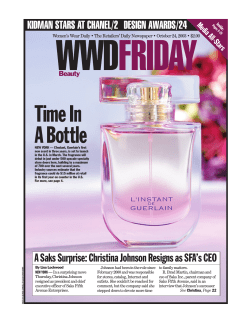
CHANEL
CHANEL Presented by: Jessica Bercier-History and Competitors Liu Paisha-Sasha-Industrial Analysis Liu Zheng-Leo-Globalization Shu Yue-Alice-SWOT Analysis History Gabrielle “Coco” Chanel Started in 1909 Known for simple and classic looks Chanel No. 5 Introduced in 1922 Still their most successful perfume today, nearly 86 years later Coco Chanel Connection with the Germans Fashion Oscar in 1957 Even after her death in 1971, she lives on as an icon to many in the fashion industry today. Chanel, post Coco Industry Analysis Global Issue The profit shrink ,especial in cosmetics Reason Disorder competition in international market Current Situation France & US France : profit down from 2007 to now US: 0.8% growth in 2007 Worldwide *cosmetics sales increase just 3.6% in 2006, not a great change in 2007 Risks High Duty In China, the customs added 60% to the cost of goods Different Concepts Compare western countries and China on perfume preference Fake Goods Difficult to distinguish In every corner, especially in developing countries Future trend Pay more attention to emerging markets Some brands are just in developed cities, not yet found in small cities, or developing countries Reducing the price---- cost of good Currently, the cost is too high for average citizens who want to buy it Expand the man cosmetics market continually Currently, not universal like woman cosmetics Chanel Competitors Gucci Based in the Netherlands Specializes in clothing, cosmetics, shoes Strong brand identity PRADA Based in Milan, Italy Fashion leader Known for its runway shows LVMH Louis Vuitton Based in Paris, France One of the oldest fashion company in the world SWOT Chanel Strength Cloth Fashion haute couture luxury goods perfume jewelry watches beauty products eyeglasses Chanel production is known for its quality. Some of the cloth is exclusively owned by Chanel. Embroidery Tweed Fabric Button Decorative Chain Cloth cont. Cut Fabric Lining Camellia and Chanel Logo Camellia is an important design factor in Chanel’s design. Chanel’s logo is two C together which has become one of the most recognized labels in the world. Karl Lagerfeld The Chanel Chief Designer who is leading Chanel to another peak in its fashion development. Chanel Perfume No5, No19, COCO, Cristall,ALLURE , CHANCE, and N°22, CUIR DE RUSSIE, GARDENIA, BOIS DES ILES, UNE FLEUR DE CHANEL and Chanel male perfume: Allure . Chanel Weakness Chanel high price Chanel limited productions Chanel beauty productions Chanel Opportunity Expand business in emerging market more rapidly. Mobile art exhibition in seven cities in China. The first is in Hong Kong. Opening of its largest global franchised store in Tokyo Chanel 2008/2009 winter season Chanel Threat Chanel counterfeits and illegal use of its double-C logo. Chanel will face a strong competition in China market and meet a lot of difficulties. Short-term Find ways to lower the prices of products in emerging markets Improve its cosmetic line Develop a men’s line of facial products Allocate the investment in expanding emerging market reasonably Pay attention to the fakes and may adopt technology to limit them Long- term Recommendations A. More focus on younger generation More ideas in clothing design More research in African market Conclusion From history to nowadays Faces opportunity and challenges Future development
© Copyright 2025











